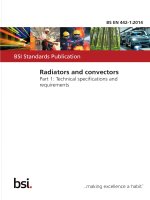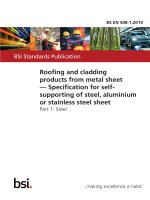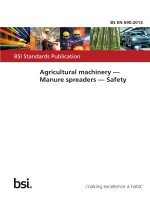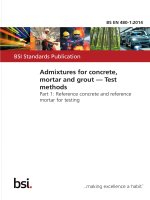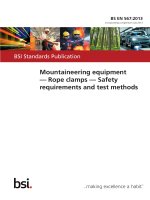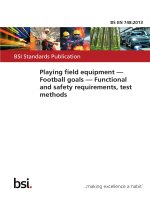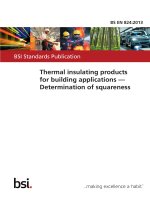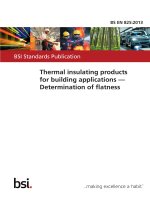Bsi bs en 00590 2013 (2014)
Bạn đang xem bản rút gọn của tài liệu. Xem và tải ngay bản đầy đủ của tài liệu tại đây (1.66 MB, 22 trang )
BS EN 590:2013
Incorporating corrigenda November 2013 and March 2014
BSI Standards Publication
Automotive fuels — Diesel
— Requirements and test
methods
BRITISH STANDARD
BS EN 590:2013
National foreword
This British Standard is the UK implementation of EN 590:2013,
incorporating corrigendum March 2014. It supersedes
BS EN 590:2009+A1:2010 which is withdrawn.
The UK participation in its preparation was entrusted to Technical
Committee PTI/2, Liquid Fuels.
A list of organizations represented on this committee can be obtained
on request to its secretary.
This publication does not purport to include all the necessary provisions
of a contract. Users are responsible for its correct application.
© The British Standards Institution 2014.
Published by BSI Standards Limited 2014
ISBN 978 0 580 86283 0
ICS 75.160.20
Compliance with a British Standard cannot confer immunity from
legal obligations.
This British Standard was published under the authority of the Standards
Policy and Strategy Committee on 30 September 2013.
Amendments/corrigenda issued since publication
Date
Text affected
30 November 2013
Implementation of corrigendum November 2013:
National Annex NA added
31 July 2014
Implementation of CEN corrigendum March 2014:
Footnote "j" in Table 1 updated
EN 590
EUROPEAN STANDARD
NORME EUROPÉENNE
EUROPÄISCHE NORM
September 2013
ICS 75.160.20
Incorporating corrigendum
2014
SupersedesMarch
EN 590:2009+A1:2010
English Version
Automotive fuels - Diesel - Requirements and test methods
Carburants pour automobiles - Carburants pour moteur
diesel (gazole) - Exigences et méthodes d'essai
Kraftstoffe für Kraftfahrzeuge - Dieselkraftstoff Anforderungen und Prüfverfahren
This European Standard was approved by CEN on 26 July 2013.
CEN members are bound to comply with the CEN/CENELEC Internal Regulations which stipulate the conditions for giving this European
Standard the status of a national standard without any alteration. Up-to-date lists and bibliographical references concerning such national
standards may be obtained on application to the CEN-CENELEC Management Centre or to any CEN member.
This European Standard exists in three official versions (English, French, German). A version in any other language made by translation
under the responsibility of a CEN member into its own language and notified to the CEN-CENELEC Management Centre has the same
status as the official versions.
CEN members are the national standards bodies of Austria, Belgium, Bulgaria, Croatia, Cyprus, Czech Republic, Denmark, Estonia,
Finland, Former Yugoslav Republic of Macedonia, France, Germany, Greece, Hungary, Iceland, Ireland, Italy, Latvia, Lithuania,
Luxembourg, Malta, Netherlands, Norway, Poland, Portugal, Romania, Slovakia, Slovenia, Spain, Sweden, Switzerland, Turkey and United
Kingdom.
EUROPEAN COMMITTEE FOR STANDARDIZATION
COMITÉ EUROPÉEN DE NORMALISATION
EUROPÄISCHES KOMITEE FÜR NORMUNG
Management Centre: Avenue Marnix 17, B-1000 Brussels
© 2013 CEN
All rights of exploitation in any form and by any means reserved
worldwide for CEN national Members.
Ref. No. EN 590:2013: E
BS EN 590:2013
EN 590:2013 (E)
BS EN 590:2013
EN 590:2013 (E)
Foreword
Contents
Page
This document (EN 590:2013) has been prepared by Technical Committee CEN/TC 19 “Gaseous and liquid
fuels, lubricants and related products of petroleum, synthetic and biological origin”, the secretariat of which is
Foreword
..............................................................................................................................................................3
held
by NEN.
1
Scope ......................................................................................................................................................4
This European Standard shall be given the status of a national standard, either by publication of an identical
2 or by
Normative
references
............................................................................................................................4
text
endorsement,
at the latest
by March 2014, and conflicting national standards shall be withdrawn at
the
latest
by
March
2014.
3
Sampling .................................................................................................................................................6
4
Pump
marking
Attention
is drawn
to the........................................................................................................................................6
possibility that some of the elements of this document may be the subject of patent
rights.
CEN
[and/or
CENELEC]
not be..........................................................................................................6
held responsible for identifying any or all such patent rights.
5
Requirements and testshall
methods
5.1
Dyes and markers ..................................................................................................................................6
This
supersedes
EN 590:2009+A1:2010.
5.2 document
Additives
.................................................................................................................................................6
5.2.1 General ....................................................................................................................................................6
This
has been prepared
under a mandate
given
to CEN
by the European Commission and the
5.2.2 document
Methylcyclopentadienyl
manganese
tricarbonyl
(MMT)
....................................................................6
.
European
Free
Trade
Association
[5]
5.3
Fatty acid methyl ester (FAME) ............................................................................................................6
5.4
Other (bio-) components .......................................................................................................................7
The
of the European
Fuels Directive
98/70/EC
[1], including
amendments 2003/17/EC [2],
5.5 requirements
Generally applicable
requirements
and related
test methods
..........................................................7
2009/30/EC
[3]
and
2011/63/EC
[4],
have
been
included.
Dates
are
included
with
all normative test method
5.6
Climate dependent requirements and related test methods .............................................................9
references
in
order
to
comply
with
the
requirements
of
the
European
Commission;
with the accompanying
5.7
Precision and dispute ........................................................................................................................
10
assurance by CEN/TC 19 that any referenced updated versions will always give similar accuracy and the
AnnexorAbetter
(normative)
Details
of inter-laboratory test programme ............................................................... 11
same
precision
(see [4]).
Bibliography ..................................................................................................................................................... 12
Significant technical changes between this European Standard and the previous edition are:
—
Inclusion of the revised EN 14214 FAME specification.
—
Specific requirements concerning the limitation of use of methylcyclopentadienyl manganese tricarbonyl
(MMT) as required by the EC have been incorporated.
—
Addition of the Fuel Ignition Tester (EN 16144) as an alternate test method to the CFR engine test.
—
Addition of Simulated Distillation by gas chromatography (GC), EN ISO 3924, as an alternate test method
to distillation by EN ISO 3405.
—
Introduction of the improved EDXRF determination technique for low sulfur contents, EN ISO 13032, in
replacement of EN ISO 20847.
Annex A is normative and contains the precision data generated on the test methods, which are the result of
inter-laboratory testing, carried out by working groups of CEN/TC 19. Many of the test methods included in
this standard were the subject of inter-laboratory testing to determine the applicability of the method and its
precision in relation to blends of automotive diesel fuel containing 10 % (V/V) or higher of different sources of
fatty acid methyl esters (FAME).
According to the CEN-CENELEC Internal Regulations, the national standards organisations of the following
countries are bound to implement this European Standard: Austria, Belgium, Bulgaria, Croatia, Cyprus, Czech
Republic, Denmark, Estonia, Finland, Former Yugoslav Republic of Macedonia, France, Germany, Greece,
Hungary, Iceland, Ireland, Italy, Latvia, Lithuania, Luxembourg, Malta, Netherlands, Norway, Poland, Portugal,
Romania, Slovakia, Slovenia, Spain, Sweden, Switzerland, Turkey and the United Kingdom.
2
3
BS EN 590:2013
EN 590:2013 (E)
BS EN 590:2013
EN 590:2013 (E)
BS EN 590:2013
EN 590:2013 (E)
Foreword
Contents
Contents
Page
Page
This
document
(EN 590:2013) has been prepared by Technical Committee CEN/TC 19 “Gaseous and liquid
Foreword
..............................................................................................................................................................3
fuels, lubricants and related products of petroleum, synthetic and biological origin”, the secretariat of which is
1
Scope
......................................................................................................................................................4
Foreword
..............................................................................................................................................................3
held
by NEN.
2
Normative
references ............................................................................................................................4
1
Scope
......................................................................................................................................................4
This European Standard shall be given the status of a national standard, either by publication of an identical
3 or by
Sampling
.................................................................................................................................................6
2
Normative
references
............................................................................................................................4
text
endorsement,
at the latest
by March 2014, and conflicting national standards shall be withdrawn at
the
latest
by
March
2014.
4
Pump marking
........................................................................................................................................6
3
Sampling
.................................................................................................................................................6
5
Requirements
test methods
..........................................................................................................6
4
Pump
marking
........................................................................................................................................6
Attention
is drawn
to theand
possibility
that some
of the elements of this document may be the subject of patent
5.1
Dyes
and
markers
..................................................................................................................................6
rights.
CEN
[and/or
CENELEC]
shall
not
be
held
responsible for identifying any or all such patent rights.
5
Requirements and test methods ..........................................................................................................6
5.2
Additives .................................................................................................................................................6
5.1
Dyes and markers ..................................................................................................................................6
5.2.1document
Generalsupersedes
....................................................................................................................................................6
This
EN 590:2009+A1:2010.
5.2
Additives .................................................................................................................................................6
5.2.2 Methylcyclopentadienyl manganese tricarbonyl (MMT) ....................................................................6
5.2.1 General ....................................................................................................................................................6
5.3 document
Fatty acid
ester (FAME)
This
hasmethyl
been prepared
under............................................................................................................6
a mandate
given
to CEN
by the European Commission and the
5.2.2 Methylcyclopentadienyl
manganese
tricarbonyl
(MMT)
....................................................................6
.
5.4
Other
(bio-)
components
.......................................................................................................................7
European
Free
Trade
Association
[5]
5.3
Fatty acid methyl ester (FAME) ............................................................................................................6
5.5
Generally applicable requirements and related test methods ..........................................................7
5.4
Other (bio-) components .......................................................................................................................7
5.6
Climate dependent
requirements
related
test methods
.............................................................9
The
of the European
Fuels and
Directive
98/70/EC
[1], including
amendments 2003/17/EC [2],
5.5 requirements
Generally applicable
requirements
and related
test methods
..........................................................7
5.7
Precision
and
dispute
........................................................................................................................
10
2009/30/EC
[3]
and
2011/63/EC
[4],
have
been
included.
Dates
are
included
with
all normative test method
5.6
Climate dependent requirements and related test methods .............................................................9
references
in orderand
toDetails
comply
the requirements
the European
Commission; with the accompanying
Annex APrecision
(normative)
inter-laboratory
test of
programme
...............................................................
11
5.7
disputeofwith
........................................................................................................................
10
assurance by CEN/TC 19 that any referenced updated versions will always give similar accuracy and the
Bibliography
.....................................................................................................................................................
12
Annex
(normative)
Details
of inter-laboratory test programme ............................................................... 11
same
orAbetter
precision
(see [4]).
Bibliography ..................................................................................................................................................... 12
Significant technical changes between this European Standard and the previous edition are:
—
Inclusion of the revised EN 14214 FAME specification.
—
Specific requirements concerning the limitation of use of methylcyclopentadienyl manganese tricarbonyl
(MMT) as required by the EC have been incorporated.
—
Addition of the Fuel Ignition Tester (EN 16144) as an alternate test method to the CFR engine test.
—
Addition of Simulated Distillation by gas chromatography (GC), EN ISO 3924, as an alternate test method
to distillation by EN ISO 3405.
—
Introduction of the improved EDXRF determination technique for low sulfur contents, EN ISO 13032, in
replacement of EN ISO 20847.
Annex A is normative and contains the precision data generated on the test methods, which are the result of
inter-laboratory testing, carried out by working groups of CEN/TC 19. Many of the test methods included in
this standard were the subject of inter-laboratory testing to determine the applicability of the method and its
precision in relation to blends of automotive diesel fuel containing 10 % (V/V) or higher of different sources of
fatty acid methyl esters (FAME).
According to the CEN-CENELEC Internal Regulations, the national standards organisations of the following
countries are bound to implement this European Standard: Austria, Belgium, Bulgaria, Croatia, Cyprus, Czech
Republic, Denmark, Estonia, Finland, Former Yugoslav Republic of Macedonia, France, Germany, Greece,
Hungary, Iceland, Ireland, Italy, Latvia, Lithuania, Luxembourg, Malta, Netherlands, Norway, Poland, Portugal,
Romania, Slovakia, Slovenia, Spain, Sweden, Switzerland, Turkey and the United Kingdom.
2
2
3
BS EN 590:2013
EN 590:2013 (E)
1 Scope
This European Standard specifies requirements and test methods for marketed and delivered automotive
diesel fuel. It is applicable to automotive diesel fuel for use in diesel engine vehicles designed to run on
automotive diesel fuel containing up to 7,0 %(V/V) Fatty Acid Methyl Ester.
NOTE
For the purposes of this European Standard, the terms “% (m/m)” and “% (V/V)” are used to represent
respectively the mass fraction and the volume fraction.
2 Normative references
The following documents, in whole or in part, are normatively referenced in this document and are
indispensable for its application. For dated references, only the edition cited applies. For undated references,
the latest edition of the referenced document (including any amendments) applies.
1)
EN 116:1997 , Diesel and domestic heating fuels - Determination of cold filter plugging point
2)
prEN 12662:2012 , Liquid petroleum products - Determination of total contamination in middle distillates,
diesel fuels and fatty acid methyl esters
1)
EN 12916:2006 , Petroleum products - Determination of aromatic hydrocarbon types in middle distillates High performance liquid chromatography method with refractive index detection
1)
EN 14078:2009 , Liquid petroleum products - Determination of fatty acid methyl ester (FAME) content in
middle distillates - Infrared spectrometry method
3)
EN 14214:2012 , Liquid petroleum products - Fatty acid methyl esters (FAME) for use in diesel engines and
heating applications - Requirements and test methods
1)
EN 15195:2007 , Liquid petroleum products - Determination of ignition delay and derived cetane number
(DCN) of middle distillate fuels by combustion in a constant volume chamber
1)
EN 15751:2009 , Automotive fuels - Fatty acid methyl ester (FAME) fuel and blends with diesel fuel Determination of oxidation stability by accelerated oxidation method
EN 16144:2012, Liquid petroleum products - Determination of ignition delay and derived cetane number
(DCN) of middle distillate fuels - Fixed range injection period, constant volume combustion chamber method
EN 16329:2013, Diesel and domestic heating fuels - Determination of cold filter plugging point - Linear cooling
bath method
2)
prEN 16576:2013 , Automotive fuels - Determination of manganese and iron content in middle distillate fuels Inductively coupled plasma optical emission spectrometry (ICP OES) method
EN 23015:1994, Petroleum products - Determination of cloud point (ISO 3015:1992)
EN ISO 2160:1998, Petroleum products - Corrosiveness to copper - Copper strip test (ISO 2160:1998)
EN ISO 2719:2002, Determination of flash point - Pensky-Martens closed cup method (ISO 2719:2002)
1)
Under revision.
2)
In preparation.
3)
This document is currently impacted by EN 14214:2012/FprA1:2013.
4
BS EN 590:2013
EN 590:2013 (E)
EN ISO 3104:1996, Petroleum products - Transparent and opaque liquids - Determination of kinematic
viscosity and calculation of dynamic viscosity (ISO 3104:1994)
EN ISO 3170:2004, Petroleum liquids - Manual sampling (ISO 3170:2004)
1)
EN ISO 3171:1999 , Petroleum liquids - Automatic pipeline sampling (ISO 3171:1988)
EN ISO 3405:2011, Petroleum products - Determination of distillation characteristics at atmospheric pressure
(ISO 3405:2011)
EN ISO 3675:1998, Crude petroleum and liquid petroleum products - Laboratory determination of density Hydrometer method (ISO 3675:1998)
EN ISO 3924:2010, Petroleum products - Determination of boiling range distribution - Gas chromatography
method (ISO 3924:2010)
EN ISO 4259:2006, Petroleum products - Determination and application of precision data in relation to
methods of test (ISO 4259:2006)
4)
EN ISO 4264:2007 , Petroleum products - Calculation of cetane index of middle-distillate fuels by the fourvariable equation (ISO 4264:2007)
1)
EN ISO 5165:1998 , Petroleum products - Determination of the ignition quality of diesel fuels - Cetane engine
method (ISO 5165:1998)
EN ISO 6245:2002, Petroleum products - Determination of ash (ISO 6245:2001)
EN ISO 10370:1995, Petroleum products - Determination of carbon residue - Micro method (ISO 10370:1993)
EN ISO 12156-1:2006, Diesel fuel - Assessment of lubricity using the high-frequency reciprocating rig (HFRR)
- Part 1: Test method (ISO 12156-1:2006)
EN ISO 12185:1996, Crude petroleum and petroleum products - Determination of density - Oscillating U-tube
method (ISO 12185:1996)
EN ISO 12205:1996, Petroleum products - Determination of the oxidation stability of middle-distillate fuels
(ISO 12205:1995)
EN ISO 12937:2000, Petroleum products - Determination of water - Coulometric Karl Fischer titration method
(ISO 12937:2000)
EN ISO 13032:2012, Petroleum products - Determination of low concentration of sulfur in automotive fuels Energy-dispersive X-ray fluorescence spectrometric method (ISO 13032:2012)
EN ISO 13759:1996, Petroleum products - Determination of alkyl nitrate in diesel fuels - Spectrometric method
(ISO 13759:1996)
EN ISO 20846:2011, Petroleum products - Determination of sulfur content of automotive fuels - Ultraviolet
fluorescence method (ISO 20846:2011)
EN ISO 20884:2011, Petroleum products - Determination of sulfur content of automotive fuels - Wavelengthdispersive X-ray fluorescence spectrometry (ISO 20884:2011)
4)
This document is currently impacted by EN ISO 4264:2007/A1:2013.
5
BS EN 590:2013
EN 590:2013 (E)
3 Sampling
Samples shall be taken as described in EN ISO 3170 or EN ISO 3171 and/or in accordance with the
requirements of national standards or regulations for the sampling of automotive diesel fuel. The national
requirements shall be set out in detail or shall be referred to by reference in a National Annex to this European
Standard.
In view of the sensitivity of some of the test methods referred to in this European Standard, particular attention
shall be paid to compliance with any guidance on sampling containers which is included in the test method
standard.
4 Pump marking
Information to be marked on dispensing pumps used for delivering automotive diesel fuel, and the dimensions
of the mark shall be in accordance with the requirements of national standards or regulations for the marking
of pumps for automotive diesel fuel. Such requirements shall be set out in detail or shall be referred to by
reference in a National Annex to this European Standard.
Labelling shall be clearly visible, easily legible and displayed at any point where diesel with metallic additives
is made available to consumers. The label shall contain: “Contains metallic additives” in the national
language(s) and shall be laid down in the National Annex to this document.
5 Requirements and test methods
5.1 Dyes and markers
The use of dyes or markers is allowed.
5.2 Additives
5.2.1 General
In order to improve the performance quality, the use of additives is allowed. Suitable fuel additives without
known harmful side-effects are recommended in the appropriate amount, to help to avoid deterioration of
driveability and emissions control durability. Other technical means with equivalent effect may also be used.
NOTE
Deposit forming tendency test methods suitable for routine control purposes have not yet been identified and
developed.
5.2.2 Methylcyclopentadienyl manganese tricarbonyl (MMT)
When methylcyclopentadienyl manganese tricarbonyl (MMT) is used, a specific labelling is required (see also
Clause 4).
MMT is a metallic additive that can be used in diesel. The presence of the MMT in diesel shall be limited to
6 mg of manganese per litre from 1 January 2011. The limit shall be 2 mg of manganese per litre from
1 January 2014.
NOTE
These requirements are subject to review following an assessment by the European Commission.
5.3 Fatty acid methyl ester (FAME)
Diesel fuel may contain up to 7,0 % (V/V) of FAME complying with EN 14214:2012, in which case the climatedependent requirements set out in 5.4.2 of EN 14214:2012 do not apply.
NOTE 1
6
A suitable method for the separation and identification of FAME is given in EN 14331 [6].
BS EN 590:2013
EN 590:2013 (E)
Climate dependent requirements for FAME as a blending component for use in diesel fuel according to this
document are set out in 5.4.3 of EN 14214:2012. The specific grades shall be specified on a national basis
according to local climatic conditions and the FAME volume in the diesel fuel.
The finished blend of diesel fuel shall also comply with the climate dependent requirements set out in 5.6. of
this document.
Cold flow additives, when used in FAME, should be specifically matched to the base diesel fuel and FAME
quality to ensure correct performance consistent with the requirements set out in this European Standard. The
choice could result in incompatibility between the cold flow additives used in the FAME and the diesel fuel.
The choice of cold flow additive technology should be a contractual matter between the fuel blender and the
FAME supplier taking into account the climatic-dependent requirements of the finished diesel fuel.
NOTE 2
Cold flow requirements for FAME as a blend component in diesel fuel are set out in Tables 3a and 3b and the
National Annex of EN 14214:2012, in order to control maximum content of saturated monoglycerides in the final EN 590
blend to ensure trouble-free operation. Work is on-going to identify a suitable test method for saturated monoglycerides or
a performance test to control this aspect of low temperature performance.
In order to improve the oxidation stability of FAME, it is strongly recommended to add oxidation stability
enhancing additives to FAME at the production stage and before storage, providing an oxidation stability
similar to that obtained with 1 000 mg/kg of 2,6-di-tert-butyl-4-hydroxytoluene (BHT, officially designated by
IUPAC as 2,6-bis(1,1-dimethylethyl)-4-methylphenol).
The similar action may be read as providing oxidation stability performance at least equal to that obtained with
1 000 mg/kg of BHT.
CAUTION — There is a potential risk of precipitate formation with oxidation stability enhancing
additives at low temperatures in low aromatic arctic fuel. Caution should therefore be taken in the
choice of oxidation stability enhancing additives to arctic grade FAME.
5.4 Other (bio-) components
Limits for adding FAME are set for technical reasons. Limits for FAME do not apply to other (renewable)
hydrocarbons such as Hydrotreated Vegetable Oil (HVO), Gas To Liquid (GTL) or Biomass To Liquid (BTL)
derived hydrocarbons, since these paraffinic diesel components are allowed in any proportions provided that
the final blend complies with the requirements of EN 590. The use of renewable feedstock at refineries is also
allowed provided that the final fuel meets the requirements of EN 590.
NOTE
A draft fuel specification for paraffinic diesel fuel has been developed [7].
5.5 Generally applicable requirements and related test methods
5.5.1 When tested by the methods indicated in Table 1, automotive diesel fuel shall be in accordance with the
limits specified in Table 1. The test methods listed in Table 1 have been assessed for application to
automotive diesel containing FAME. Precision data from inter-laboratory test programmes are given in
normative Annex A, where these were found to be different from the precision data given in the test methods
for neat petroleum products.
5.5.2 The limiting value for the carbon residue given in Table 1 is based on product prior to addition of ignition
improver, if used. If a value exceeding the limit is obtained on finished fuel in the market, EN ISO 13759 shall
be used as an indicator of the presence of a nitrate-containing compound. If an ignition improver is thus
proved present, the limit value for the carbon residue of the product under test cannot be applied. The use of
additives does not exempt the manufacturer from meeting the requirement of maximum 0,30 % (m/m) of
carbon residue prior to addition of additives.
5.5.3 Diesel fuel shall be free from any adulterant or contaminant that may render the fuel unacceptable for
use in diesel engine vehicles.
NOTE
For further information on preventing contamination by water or sediment that may occur in the supply chain,
or for cross-contamination, it is advisable to check CEN/TR 15367–1 [8] or CEN/TR 15367–3 [9] respectively.
7
BS EN 590:2013
EN 590:2013 (E)
Table 1 — Generally applicable requirements and test methods for automotive diesel fuel
Property
Unit
Limits
minimum
maximum
Cetane number
51,0
–
46,0
–
820,0
845,0
% (m/m)
–
8,0
mg/kg
–
10,0
Above 55,0
6,0
2,0
–
Cetane index
Density at 15 °C
kg/m
Polycyclic aromatic hydrocarbons
Sulfur content
d
f
Manganese content
until 2013–12–31
from 2014 to 01–01 onwards
Flash point
3
mg/l
°C
a
Test method
(See Clause 2)
EN ISO 5165
EN 15195
EN 16144
EN ISO 4264
b
c
EN ISO 3675
EN ISO 12185
EN 12916
EN ISO 20846
EN ISO 20884
EN ISO 13032
prEN 16576
EN ISO 2719
Carbon residue
(on 10 % distillation residue)
Ash content
% (m/m)
–
0,30
EN ISO 10370
% (m/m)
–
0,010
EN ISO 6245
Water content
mg/kg
–
200
EN ISO 12937
Total contamination
mg/kg
–
24
EN 12662
Copper strip corrosion
(3 h at 50 °C)
rating
g
Fatty acid methyl ester (FAME) content
i
Oxidation stability
Lubricity, corrected wear scar diameter (wsd 1,4) at
60 °C
Viscosity at 40 °C
class 1
h
EN ISO 2160
% (V/V)
-
7,0
EN 14078
3
–
j
20
–
25
460
EN ISO 12205
EN 15751
EN ISO 12156-1
2
2,000
4,500
EN ISO 3104
< 65
EN ISO 3405
EN ISO 3924
g/m
h
µm
mm /s
k, l
Distillation
% (V/V) recovered at 250 °C
% (V/V) recovered at 350 °C
95 % (V/V) recovered at
e
% (V/V)
% (V/V)
°C
85
m
360
NOTE Requirements in bold refer to the European Fuels Directive 98/70/EC [1], including amendments 2003/17/EC [2],
2009/30/EC [3] and 2011/63/EU [4].
a
See also 5.7.1.
b
See also 5.7.4.
c
See also 5.7.2.
d
For the purposes of this European Standard, polycyclic aromatic hydrocarbons are defined as the total aromatic hydrocarbon content
less the mono-aromatic hydrocarbon content, both as determined by EN 12916.
e
See also 5.7.3.
f
See also 5.2.2.
g
See also 5.5.2 and Annex A.
h
Further investigation into the total contamination test method to improve the precision, particularly in the presence of FAME, is being
carried out by CEN.
i
FAME shall meet the requirements of EN 14214, see [3].
For diesel fuel containing FAME above 2 % (V/V) this is an additional requirement.
j
k
For the calculation of the cetane index the 10 %, 50 % and 90 % (V/V) recovery points are also needed.
l
The limits for distillation at 250 °C and 350 °C are included for diesel fuel in line with EU Common Customs tariff.
m
EN ISO 3924 gives instructions to convert to ISO 3405-equivalent data. See also 5.7.5.
8
BS EN 590:2013
EN 590:2013 (E)
5.6 Climate dependent requirements and related test methods
5.6.1 For climate-dependent requirements, options are given to allow for seasonal grades to be set
nationally. The options are for temperate climates six CFPP (cold filter plugging point) grades and for arctic or
severe winter climates five different classes. Climate-dependent requirements are given in Table 2 (temperate
climates) and Table 3 (arctic or severe winter climates). When tested by the methods given in Table 2 and
Table 3, automotive diesel fuel shall be in accordance with the limits specified in these tables.
Table 2 — Climate-related requirements and test methods — Temperate climates
Property
CFPP
a
b
Unit
°C, max.
Limits
Grade
A
+5
Grade
B
0
Grade
C
−5
Grade
D
−10
Test method
Grade
E
−15
Grade
F
−20
a
(See Clause 2)
b
EN 116
EN 16329
See also 5.7.1.
See 5.7.6.
Table 3 — Climate-related requirements and test methods — Arctic or severe winter climates
Property
Units
class
1
−26
Limits
class
2
−32
a
CFPP
°C, max.
class
0
−20
Cloud point
°C, max.
−10
−16
−22
−28
−34
kg/m ,min.
3
kg/m , max.
2
mm /s, min.
2
mm /s, max.
minimum
800,0
845,0
1,500
4,000
51,0
800,0
845,0
1,500
4,000
51,0
800,0
840,0
1,500
4,000
51,0
800,0
840,0
1,400
4,000
51,0
800,0
840,0
1,200
4,000
51,0
minimum
49,0
49,0
48,0
47,0
47,0
minimum
46,0
46,0
46,0
43,0
43,0
EN ISO 5165
EN 15195
EN 16144
d
EN ISO 5165
EN 15195
EN 16144
EN ISO 4264
EN ISO 3405
EN ISO 3924
3
Density at 15 °C
Viscosity at 40 °C
Cetane number EU
Cetane number
e
f
Cetane index
class
3
−38
class
4
−44
Test method
(See Clause 2)
g, h
Distillation
recovered at 180 °C
% (V/V), max.
10,0
10,0
10,0
10,0
10,0
recovered at 340 °C
% (V/V), min.
95,0
95,0
95,0
95,0
95,0
a
b
c
d
e
f
g
h
i
b
EN 116
EN 16329
EN 23015
c
EN ISO 3675
EN ISO 12185
EN ISO 3104
d
i
See also 5.7.1.
See also 5.7.6.
See also 5.7.2.
See also 5.7.4.
In countries where the European Fuels Directive 98/70 EC [1] including amendments 2003/17/EC [2],
2009/30/EC [3] and 2011/63/EU [4] applies.
In countries where the European Fuels Directive 98/70 EC [1] including amendments 2003/17/EC [2],
2009/30/EC [3] and 2011/63/EU [4] does not apply.
EU Common Customs Tariff definition of gas oil may not apply to the grades defined for use in arctic or severe
winter climates.
For the calculation of the cetane index the 10 % (V/V), 50 % (V/V) and 90 % (V/V) recovery points are also needed.
See also 5.7.5.
9
BS EN 590:2013
EN 590:2013 (E)
5.6.2 In a National Annex to this European Standard, each country shall detail requirements for a summer
and a winter grade and may include (an) intermediate and/or regional grade(s) which shall be justified by
national meteorological data.
5.7 Precision and dispute
5.7.1 All test methods referred to in this European Standard include a precision statement. In cases of
dispute, the procedures for resolving the dispute and interpretation of the results based on test method
precision, described in EN ISO 4259, shall be used.
5.7.2
In cases of dispute concerning density, EN ISO 3675 shall be used.
5.7.3
In cases of dispute concerning sulfur content, either EN ISO 20846 or EN ISO 20884 shall be used.
5.7.4 In cases of dispute concerning cetane number, EN ISO 5165 shall be used. For the determination of
cetane number alternative methods to those indicated in Table 1 and Table 3 may also be used, provided that
these methods originate from a recognised method series, and have a valid precision statement, derived in
accordance with EN ISO 4259, which demonstrates precision at least equal to that of the referenced method.
The test result, when using an alternative method, shall also have a demonstrable relationship to the result
obtained when using the referenced method.
5.7.5
In cases of dispute concerning distillation, EN ISO 3405 shall be used.
5.7.6
In cases of dispute concerning CFPP, EN 116 shall be used.
10
BS EN 590:2013
EN 590:2013 (E)
Annex A
(normative)
Details of inter-laboratory test programme
Table A.1 presents the precision data obtained in inter-laboratory testing programmes by CEN/TC 19 [10] and
the EI [11], that differ from those of test methods listed in Table 1 and that at the time of publication of this
European Standard were not yet revised.
NOTE
values:
The following methods were found to have precision data for 5 % (V/V) FAME blends similar to the published
—
Ash content:
EN ISO 6245,
—
Oxidation stability: EN ISO 12205,
—
CFPP:
EN 116.
Table A.1 — Precision data updates
Property
Test method
Unit
2
Viscosity at 40 °C
EN ISO 3104
mm /s
Flash point
EN ISO 2719
°C
Carbon residue
EN ISO 10370
% (m/m)
CEN/TC 19 data for
5 % (V/V) FAME blend
r = 0,001 1 X
R = 0, 018 X
r = 2,0
R = 3,5
0,5
r = 0,143 0 X
0,5
R = 0,212 5 X
where
r
is repeatability (EN ISO 4259)
R is reproducibility (EN ISO 4259)
X is the mean of two results being compared
11
BS EN 590:2013
EN 590:2013 (E)
Bibliography
[1]
Directive 98/70/EC of the European Parliament and of the Council of 13 October 1998 relating to the
quality of petrol and diesel fuels and amending Council Directive 93/12/EEC
[2]
Directive 2003/17/EC of the European Parliament and of the Council of 3 March 2003 amending
Directive 98/70/EC relating to the quality of petrol and diesel fuels and amending Council Directive
93/12/EEC
[3]
Directive 2009/30/EC of the European Parliament and of the Council of 23 April 2009 amending
Directive 98/70/EC as regards the specification of petrol, diesel and gas-oil and introducing a
mechanism to monitor and reduce greenhouse gas emissions and amending Council Directive
1999/32/EC as regards the specification of fuel used by inland waterway vessels and repealing
Directive 93/12/EEC
[4]
Directive 2011/63/EU of 1 June 2011 amending, for the purpose of its adaptation to technical progress,
Directive 98/70/EC of the European Parliament and of the Council relating to the quality of petrol and
diesel fuels
[5]
Mandate M/394 - Mandate to CEN on the revision of EN 590 to increase the concentration of FAME
and FAEE to 10% v/v, 13 November 2006
[6]
EN 14331:2004, Liquid petroleum products - Separation and characterisation of fatty acid methyl
esters (FAME) from middle distillates - Liquid chromatography (LC)/gas chromatography (GC) method
[7]
CEN/TS 15940, Automotive fuels - Paraffinic diesel fuel from synthesis or hydrotreatment Requirements and test methods
[8]
CEN/TR 15367-1, Petroleum products - Guide for good housekeeping - Part 1. Automotive diesel fuels
[9]
CEN/TR 15367-3, Petroleum products - Guide for good housekeeping - Part 3. Cross contamination
[10]
CEN/TR 15160, Petroleum and related products - Applicability of diesel fuel test methods for Fatty
Acid Methyl Esters (FAME) - Information and results on round robin tests
[11]
EI Research Report on IP 398 and EN ISO 10370, under publication, available from the Energy
Institute, 61 New Cavendish Street, London W1G 7AR, England
12
BS EN 590:2013
EN 590:2013 (E)
National Annex NA
(normative)
Sampling requirements
NA.1 Introduction
This National Annex gives the sampling requirements to comply with Clause 3 of this standard.
NA.2 Normative references
The following referenced documents are indispensable for the application of this National Annex. For
undated references, the latest edition of the referenced document (including any amendments) applies.
BS EN ISO 3170, Petroleum liquids — Manual sampling (dual numbered as BS 2000-475).
BS EN ISO 3171, Petroleum liquids — Automatic pipeline sampling (dual numbered as BS 2000-476).
BS EN 14275, Automotive fuels — Assessment of petrol and diesel fuel quality — Sampling from retail
site pumps and commercial site fuel dispensers (dual numbered as BS 2000-509).
NA.3 Sampling
NA.3.1 Sampling from storage tanks
All sampling from storage tanks shall be carried out in accordance with the relevant procedures given
in BS EN ISO 3170/BS 2000-475.
NA.3.2 Sampling from pipelines
All sampling from pipelines shall be carried out in accordance with the relevant procedures given in
either BS EN ISO 3170/BS 2000-475 or BS EN ISO 3171/BS 2000-476.
NA.3.3 Sampling from retail site pumps and commercial site fuel dispensers
All sampling from retail site pumps and commercial site fuel dispensers shall be carried out in accordance
with the relevant procedures given in BS EN 14275/BS 2000-509.
NA.3.4 Labelling and transport
Full and legible information relating to the source of the sample shall be attached to the can in such a
manner that it shall not easily become detached.
NOTE 1
If required, the sample may be sealed and labelled to maintain its legal integrity.
NOTE 2
Attention is drawn to:
— the European Agreement Concerning the International Carriage of Dangerous Goods by Road
(ADR) as amended, particularly with regard to the provisions for “Limited Quantities”;
1
13
BS EN 590:2013
EN 590:2013 (E)
— the Carriage of Dangerous Goods (Classification, Packaging and Use of Transportable Pressure
Receptacles) Regulations 2004 (as amended);
— the Carriage of Dangerous Goods by Road Regulations 1996 (as amended), with reference to the
labelling and transport of samples.
2
14
BS EN 590:2013
EN 590:2013 (E)
National Annex NB
(normative)
Pump marking requirements
NB.1 Introduction
This National Annex gives the pump marking requirements to comply with clauses 4 and 5.2.2 of this
standard.
NB.2 Requirements
NB.2.1 Pump marking
The following information shall be marked on each retail dispensing pump or container used for
delivering diesel (conforming to BS EN 590:2013) into the consuming vehicle:
a)
The name or mark of the supplier or vendor of the diesel fuel.
b) The designation “Diesel BS EN 590” displayed as shown in Figure NB.1. The minimum dimensions
of this mark shall be as shown in Figure NB.1 (see Note 1) and the colour used for the design and
lettering shall be in clear contrast to the background (see Notes 2 and 3).
Dimensions are in millimetres
Diesel
BS EN 590
Figure NB.1 — Form of marking for automotive diesel
The mark shall be in a position where it can be seen by the person dispensing fuel.
NB.2.2 Marking for metallic additive content
In accordance with clauses 4 and 5.2.2 the words “Contains metallic additives” shall be displayed at any
point where automotive diesel containing metallic additives is made available to consumers. The form
and minimum dimensions are shown in Figure NB.2. Where this label is necessary it is not necessary
for this mark to form an integral part of the label shown in Figure NB.1, although it shall also be in a
position where it can be seen by the person dispensing fuel.
3
15
BS EN 590:2013
EN 590:2013 (E)
Dimensions are in millimetres
CONTAINS
METALLIC
ADDITIVES
Figure NB.2 — Form of marking for automotive diesel containing metallic additives
NB.2.3 Nozzle
The dispensing nozzle shall be predominantly colour-coded black, forward of the grip.
NOTE 1 Marking BS EN 590 on or in relation to a product represents a manufacturer’s declaration of conformity,
i.e. a claim by the manufacturer that the product meets the requirements of the standard. The accuracy of the
claim is solely the claimant’s responsibility. Such a declaration is not to be confused with third-party certification of
conformity, which may also be desirable.
NOTE 2 The minimum dimensions of the mark given in Figure NB.1 have been selected to enable its application to
pumps of the smallest anticipated dimensions. It is strongly recommended that, in the interests of visibility to the
motorist, larger dimensions be used wherever possible.
NOTE 3 It is recommended that the prominent colour should be black. The preferred colour is colour number 642
‘Night’ of BS 381C:1996.
NOTE 4 Attention is drawn to the relevant marking provisions of the Measuring Instruments legislation: SI 2006
No. 1266 and SI 2006 No. 2234.
4
16
BS EN 590:2013
EN 590:2013 (E)
National Annex NC
(normative)
Climate-dependent requirements
NC.1 Introduction
This National Annex gives the climate-dependent requirements to comply with Clause 5.6 of this standard.
NC.2 Requirements
For the purposes of this British Standard, the following grades shall apply:
Summer
Winter
For delivery from refineries and
imports into the United Kingdom
16 March to 15 October
inclusive
CFPP Grade C
16 October to 15 March
inclusive
CFPP Grade E
For delivery from terminals
(including refinery-based terminals)
16 March to 31 October
inclusive
CFPP Grade C
01 November to 15 March
inclusive
CFPP Grade E
For sales from the retail pump
16 March to 15 November
inclusive
CFPP Grade C
16 November to 15 March
inclusive
CFPP Grade E
NOTE 1 The date for the change from summer grade to winter grade will be reviewed in the light of experience.
NOTE 2 2 At
seasonal
change-over
points,
product
should
not benot
deemed
to be non-conformant
BS EN 590:2013,
Atthe
the
seasonal
change-over
points,
product
should
be deemed
to be out of to
compliance
with
providing
it:
BS EN 590:2013,
providing it:
i)
to the
previous
season’s
quality,
and
i) conforms
complies with
the
previous
season’s
quality,
and
ii) is stored in a filling station tank to which fewer than three deliveries have been made in the four weeks prior to
the relevant sales date in BS EN 590:2013.
NOTE 3 A ‘refinery-based terminal’ is a facility located within a refinery boundary which is used to load fuel onto
road tanker vehicles for delivery to retail service stations and other end-consumers.
5
17
This page deliberately left blank
This page deliberately left blank
NO COPYING WITHOUT BSI PERMISSION EXCEPT AS PERMITTED BY COPYRIGHT LAW
British Standards Institution (BSI)
BSI is the national body responsible for preparing British Standards and other
standards-related publications, information and services.
BSI is incorporated by Royal Charter. British Standards and other standardization
products are published by BSI Standards Limited.
About us
Revisions
We bring together business, industry, government, consumers, innovators
and others to shape their combined experience and expertise into standards
-based solutions.
Our British Standards and other publications are updated by amendment or revision.
The knowledge embodied in our standards has been carefully assembled in
a dependable format and refined through our open consultation process.
Organizations of all sizes and across all sectors choose standards to help
them achieve their goals.
Information on standards
We can provide you with the knowledge that your organization needs
to succeed. Find out more about British Standards by visiting our website at
bsigroup.com/standards or contacting our Customer Services team or
Knowledge Centre.
Buying standards
You can buy and download PDF versions of BSI publications, including British
and adopted European and international standards, through our website at
bsigroup.com/shop, where hard copies can also be purchased.
If you need international and foreign standards from other Standards Development
Organizations, hard copies can be ordered from our Customer Services team.
Subscriptions
Our range of subscription services are designed to make using standards
easier for you. For further information on our subscription products go to
bsigroup.com/subscriptions.
With British Standards Online (BSOL) you’ll have instant access to over 55,000
British and adopted European and international standards from your desktop.
It’s available 24/7 and is refreshed daily so you’ll always be up to date.
You can keep in touch with standards developments and receive substantial
discounts on the purchase price of standards, both in single copy and subscription
format, by becoming a BSI Subscribing Member.
PLUS is an updating service exclusive to BSI Subscribing Members. You will
automatically receive the latest hard copy of your standards when they’re
revised or replaced.
To find out more about becoming a BSI Subscribing Member and the benefits
of membership, please visit bsigroup.com/shop.
With a Multi-User Network Licence (MUNL) you are able to host standards
publications on your intranet. Licences can cover as few or as many users as you
wish. With updates supplied as soon as they’re available, you can be sure your
documentation is current. For further information, email
BSI Group Headquarters
389 Chiswick High Road London W4 4AL UK
We continually improve the quality of our products and services to benefit your
business. If you find an inaccuracy or ambiguity within a British Standard or other
BSI publication please inform the Knowledge Centre.
Copyright
All the data, software and documentation set out in all British Standards and
other BSI publications are the property of and copyrighted by BSI, or some person
or entity that owns copyright in the information used (such as the international
standardization bodies) and has formally licensed such information to BSI for
commercial publication and use. Except as permitted under the Copyright, Designs
and Patents Act 1988 no extract may be reproduced, stored in a retrieval system
or transmitted in any form or by any means – electronic, photocopying, recording
or otherwise – without prior written permission from BSI. Details and advice can
be obtained from the Copyright & Licensing Department.
Useful Contacts:
Customer Services
Tel: +44 845 086 9001
Email (orders):
Email (enquiries):
Subscriptions
Tel: +44 845 086 9001
Email:
Knowledge Centre
Tel: +44 20 8996 7004
Email:
Copyright & Licensing
Tel: +44 20 8996 7070
Email:

